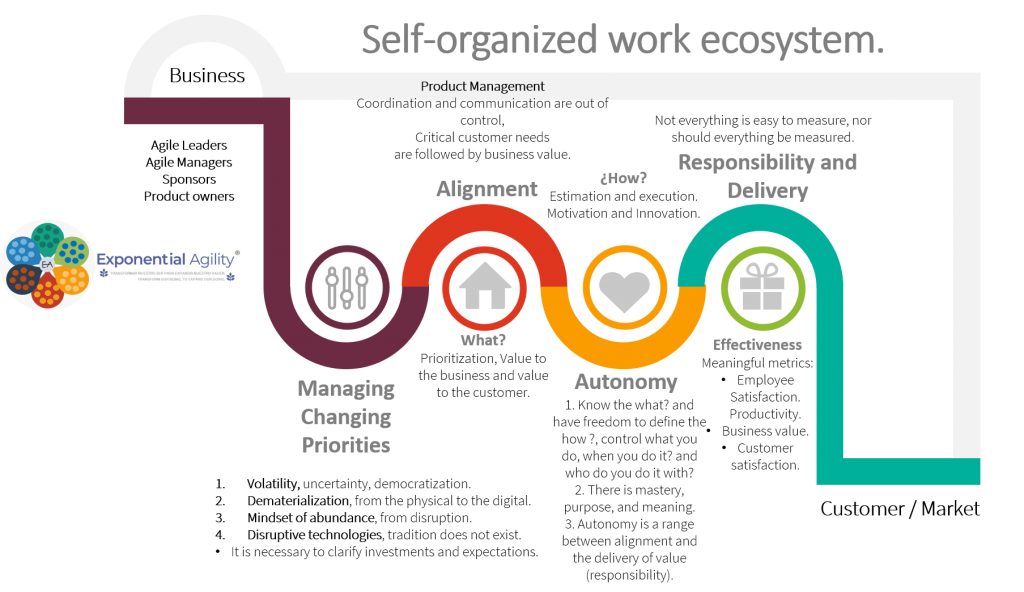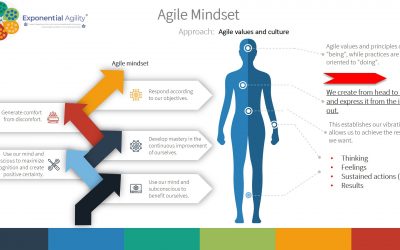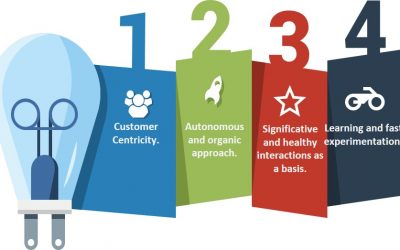A practical approach to self-organization in the workplace.
We will continue with the theme of self-organization, we have gone from the abstract to the concrete, now we will land the context and its elements in a practical way. Making a synthesis, a self-organized system, stands out for the following:
- Internal regulation, the system does not require external intervention to regulate itself.
- Positive feedback on behaviors creates the rules, if a behavior is effective in releasing value, then it becomes learning, learning fast give us advantage.
- The strength lies in creating and maintaining new behaviors and contexts, adaptability does not mean creating membership, many times it means creating something new.
- To create a self-organized work ecosystem, it is necessary that the environment has the following elements:
4.1. Alignment, Autonomy: which implies the development of (1) mastery, clarity in the (2) purpose and (3) meaning, in addition to focus on delivering results, being responsible.

Figure 1: A self-organizing work ecosystem. Miguel Martínez, own elaboration (2020).
For this, it is necessary to know the market conditions, which today are given by:
- Volatility, the conditions of uncertainty due to the democratization of access to opportunities and the democratization of consumption.
- Dematerialization, companies dematerialize what was once physical and create new products and revenue streams in months, sometimes weeks.
- Abundance mindset, the potential of entrepreneurs to disrupt industries and corporate giants is greater, unexpectedly extinguishing.
- Disruptive technologies, technology is disrupting traditional business processes, and they will never be the same again.
A practical example, we can see today if we compare the elements that existed in the market in November 2019, with those that exist today in August 2020, the pandemic has created a very volatile market, has accelerated the digital transformation as an element to counteract physical communication towards virtual communication, and the continuity of business operations, trends that according to analysts will increase as a measure to counteract the economic recession we are entering.

Figure 2: A Global Context Business. Miguel Martínez, own elaboration (2020).
As executive leaders it is necessary to know and promote:
- Investments and their benefits, to constantly adjust our expectations about the products / services we build
- Generate a strategic and tactical commitment to the value of self-organization and agility,
- Defining and checking the product strategy, which implies a constant adjustment of the product / customer gap, in order to check our hypotheses in a VUCA environment.
All of this guides the management of changing priorities, which is the context of alignment:
- Determine what? priorities and definition of value.
- Know the capabilities of the teams and create commitment to develop those required.
- Co-create and socialize all these elements.
When we define in real practice the what? we have to:
- Develop strategy and tactics through a moon-shoot and a constant competitive analysis of the market.
- Customer centricity, profitability follows purpose, this is very important and becomes a key indicator of the progress of an agile transformation towards a sustained approach, if it does not exist, it is most likely that there is no transformation.
- Manage and facilitate the needs, to create operational and commercial scalability, let’s remember, let’s think big, let’s execute little by little and with discipline, to learn quickly without taking our eyes off our vision or moonshot.
We must deliberately create Autonomy, which implies:
- Know the what? and have freedom to define the how? control what you do, when you do it? and who do you do it with?
- There is mastery, purpose, and meaning.
- Autonomy is a range between alignment and the delivery of value (responsibility), it must be deliberately designed so that we define the type of company we want to have.
When we define the how in real practice, we have to:
- Freedom to innovate and create, psychological security.
- Estimation and disciplined execution: the apple has no flavor by itself, the flavor is partly given by the climate, who grows it and who harvests it.
- Experimentation, positive feedback, and inspection and adaptation.
To close this range, we have the responsibility and delivery, which implies:
- Not everything is easy to measure, not everything should be measured, focus on meaningful metrics.
- We take advantage of learning by experimenting in a disciplined way, vision big, start small, and iteratively advance to outcome.
- We deliver value and also build in an emergent way a motivated team to do it and an environment.
Let us remember that the delivery of value must focus on how to make more effective, the how.
- We define where we want to go.
- How will we do it?
- How will we know that we are arriving?
Some of the significant metrics, which we suggest using are
- Employee satisfaction.
- Customer satisfaction.
- Value delivered to the business.
- Psychological safety.
The creation of a constructivist environment should not only occur in the area of education, let us remember that for there to be interaction, a constructivist learning environment is the workplace, under a self-organized approach.
Miguel Martínez, August 11th, 2020.
Bibliography:
- Avery, Christopher M., et al. Teamworking Is an Individual Skill: Getting Your Work Done When Sharing Responsibility. Berrett-Koehler, 2001.
- Pichler, R. (2016). Strategize: Product Strategy and Product Roadmap Practices for the Digital Age (1st ed.). Buckinghamshire, UK: Pichler Consulting.
- Pink, Daniel H. Drive the Surprising Truth about What Motivates Us. Riverhead Books, 2009.
- Koestenbaum, P., & Block, P. (2001). Freedom and Accountability at Work: Applying Philosophic Insight to the Real World (1st ed.). Hoboken, NJ, United States: Wiley.
- Wiseman, Liz, and Stephen R. Covey. Multipliers: How the Best Leaders Make Everyone Smarter. HarperBusiness, an Imprint of HarperCollinsPublishers, 2017.
- Wojcicki, Esther. How to Raise Successful People: Simple Lessons for Radical Results. Houghton Mifflin Harcourt, 2019.




